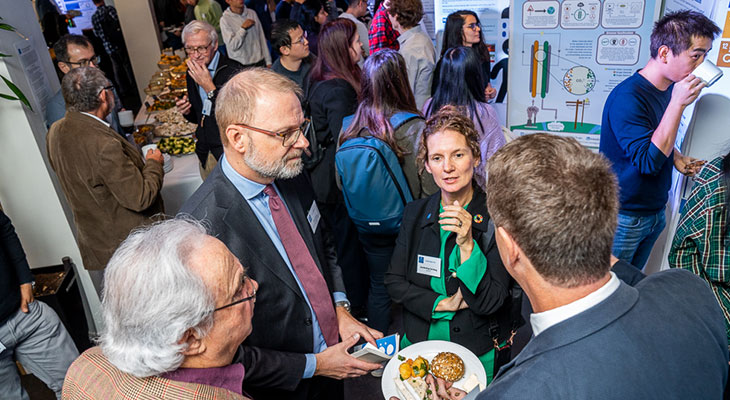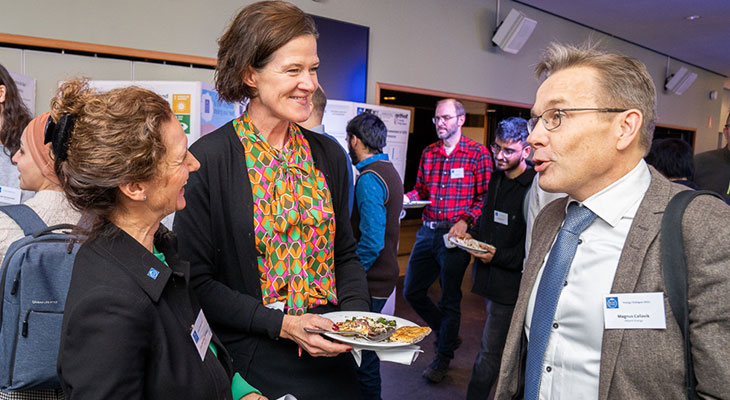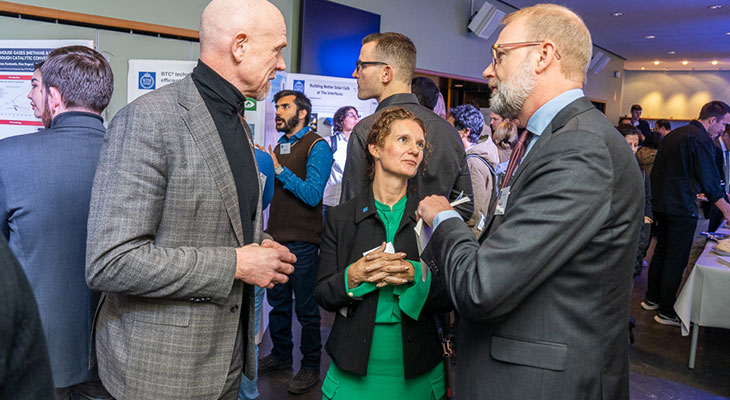Collaboration and internationalisation top the agenda at this year’s KTH Energy Dialogue
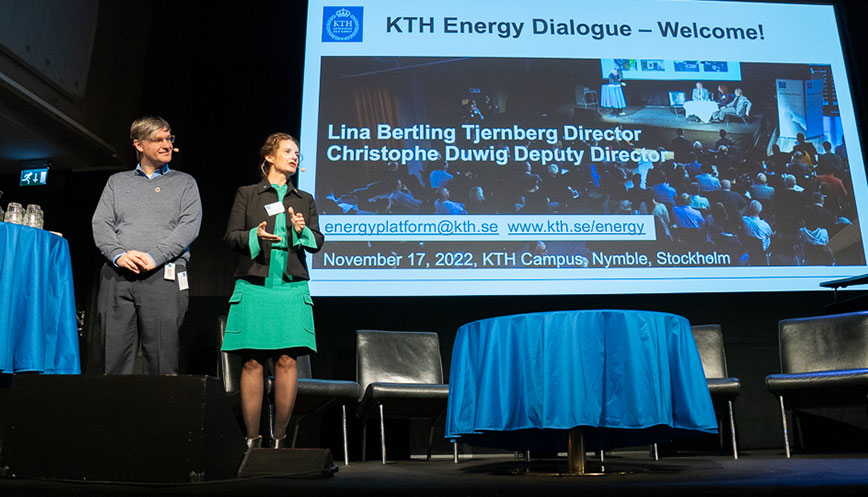
This year’s KTH Energy Dialogue, which is organised within the auspices of the KTH Energy Platform, attracted a full house at Nymble. The event focused on collaboration and internationalisation, themes that were picked up in four panel discussions.

The KTH Energy Dialogue began with an authentic cultural experience when Katariina Holma and Linda Evers from the Stockholm University of the Arts (SKH) sang Via Resti Servita from Mozart’s The Marriage of Figaro with piano accompaniment by Olga Tomilina.
“We’ve long wanted to include a cultural experience in KTH Energy Dialogue, and this year it finally happened - and from our campus neighbours SKH, whose opera lessons are now conducted in premises that were previously used for our high-voltage research,” says Lina Bertling Tjernberg.
The nearly 300 attendees were welcomed by Bertling Tjernberg, KTH Energy Platform Director, and Deputy Director Christophe Duwig, who were panellists and moderators at this year’s event.
Co-operation for sustainable development
The first panel discussion of the day was entitled Sustainable Growth with Co-operation from Business, Politics, Academia. The panel included Robert Andrén, Director General of the Swedish Energy Agency, Anna Kinberg Batra, Chair of Swedish Solar Energy Association, Tobias Krantz, Chair of the European High-Level Group on Systems Innovation, Victoria Van Camp, winner of the Royal Swedish Academy of Engineering Sciences’ (IVA) gold medal 2022 and board member of SR Energy. The panel was moderated by Duwig.
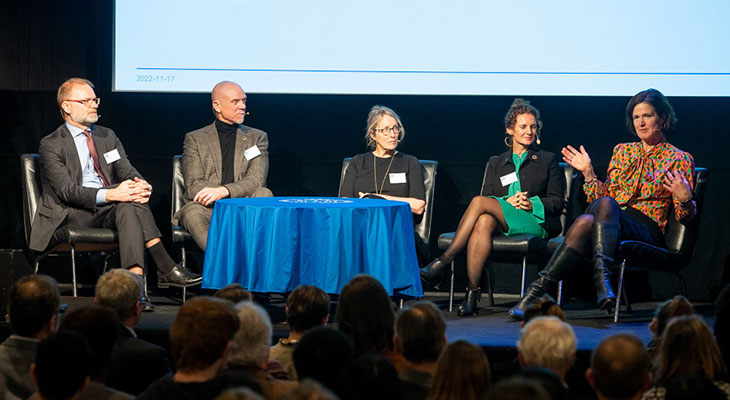
Andrén began by highlighting the importance of the KTH Energy Dialogue as a key meeting place for academia, business and the public sector. He described students’ participation as particularly important.
“You are the ones who will manage the energy system of tomorrow, which needs to be sustainable and fossil-free,” Adrén said.
He emphasised the role of the Swedish Energy Agency as one of the largest financial backers of research in Sweden and one of the driving forces in the green transition to sustainable and fossil-free energy types. A greater degree of co-operation between academia, business and politicians is required for the transition to succeed.
“Today, business is the driving force in the green transition, and academia’s role is to show business what solutions are available. The role of politicians is to understand the solutions and facilitate the transition,” said Kinberg Batra.
Krantz highlighted the opportunities that Sweden’s upcoming presidency of the EU could provide from his background as Sweden’s former Minister of Higher Education and Research.
“During our previous EU presidency, financing of the International Thermonuclear Experimental Reactor (ITER) was one of the key issues. My task today as chairman of a high-level group within the EU is to improve conditions for research and innovation that can drive the green transition. This is where co-operation between business, academia and organisations is vital.”
Van Camp spoke about her background at SKF where she worked on sustainable business models and helped customers reduce energy consumption and increase the lifespan of their components.
“The best energy is the energy we don’t use. If the world’s approximately 300 million electric motors met the highest energy classification standards, we’d save almost ten per cent of our energy consumption. This is where politics, industry and academia can work together because we need to get ahead: and we can do a lot with existing technology and small steps.”
She also highlighted the significant industrial development taking place in northern Sweden, bringing with it a huge need for labour, schools, healthcare and infrastructure.
“We need to look at the entire value chain to ensure that this development really succeeds.”
Bertling Tjernberg also raised the actual goal of the transition.
“The green transition is a process that requires long-term goals. We also need to understand the change better, why it’s happening and where we are going. Without that understanding, we won’t be able to achieve the goals,” Bertling Tjernberg said.
But do we have the necessary conditions in place to succeed, Duwig asked the panel.
“We absolutely have the right tools and the ability to innovate. But I’m afraid we’re failing to look at the whole value chain, how we’re going to scale up new solutions, and ensure they’re accepted. Academia faces the challenge of not working in silos to find interdisciplinary ways of working, and connect more actors,” Andrén said.
Kinberg Batra spoke about the upheaval of public debate in recent years.
“When I was active as a politician, virtually nobody was talking about fossil-free solutions or sustainable energy systems. We’ve seen a dramatic change in recent years, and now these are areas that engage most people,” she said.
She drew a parallel with India’s development, where access to knowledge and research is creating opportunities to avoid dependence on fossil fuels.
“The next step is for the world’s politicians to understand the opportunities, and for us to see the potential in sharing new technologies and solutions globally. We have more knowledge today than ever before, but it’s vital that we use it,” Kinberg Batra said.
Bertling Tjernberg stressed the need for a global perspective and collaboration.
“The research community is global by its very nature. At the same time, walls and rules are being erected today that prevent international collaboration, which is unfortunate. This unfortunate trend reinforces the importance of us continuing our international collaboration.”
The panel also agreed that access to skills is crucial, both in the short and long term. This is one of the reasons why the Energy Platform is organising a day on this theme on 5th December: Future competence for a sustainable energy system .
The story behind the ITER
The panel discussion was followed by a presentation by Richard Pitts, Leader of the Experiments and Plasma Operation Section of ITER, entitled ITER: Putting the Sun in Box . He gave a background bursting with knowledge about the fusion technology including parallels with the fusion processes of the sun and the technology’s development.
“The Sun produces four million times more energy in one second than we do on Earth in a whole year,” Pitts explained.
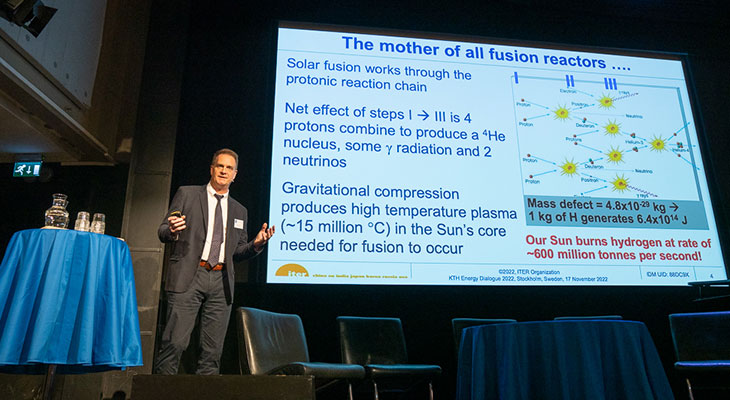
He spoke about some of the more fanciful claims made about the potential of fusion technology and actual progress that has been made. He also gave a detailed background to the ongoing construction of ITER, the world’s largest tokamak reactor to date, which is the name given to the technique of enclosing plasma using magnetic fields.
“ITER is backed by an international grouping of countries that includes the EU, China, India, Japan, South Korea, Russia and the US. Together they represent more than half of the world’s population,” Pitts said.
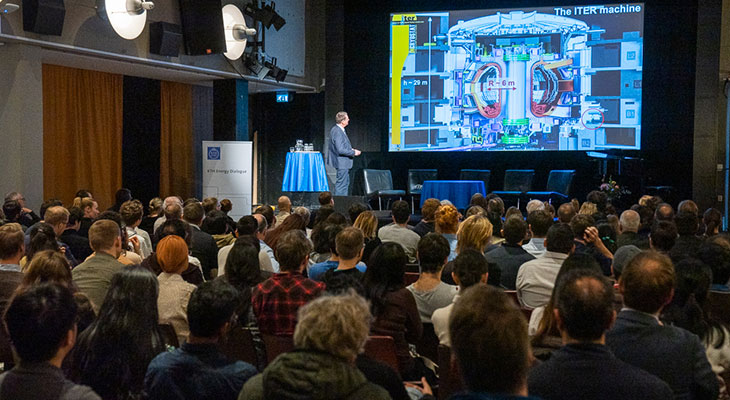
The decision to build the ITER was taken back in 1985 and construction began in 2009.
“The ITER is a development step in which we have to demonstrate that the fusion technology can work, not the final step in building a demonstration reactor.”
The aim of the project is to demonstrate the technology’s potential in the next two decades. Details of the ITER’s planned development can be found in this report .
“Fusion technology is not the solution to today’s climate crisis, but it could become an important part of the mix of different energy technology solutions of the future,” Pitts said.
Current technological developments
Next up was a panel discussion, moderated by Bertling Tjernberg, entitled Technologies for Future Energy, in which Pitts shared the stage with Lorenzo Frassinetti, Associate Professor in Fusion Plasma Physics, Alberto Garcia Fernandez, Postdoc at Applied Physical Chemistry, Göran Lindbergh, Professor and leader of Agenda 2030 centre PUSH, and Pär Olsson, Professor and leader of Agenda 2030 centre SUNRISE.
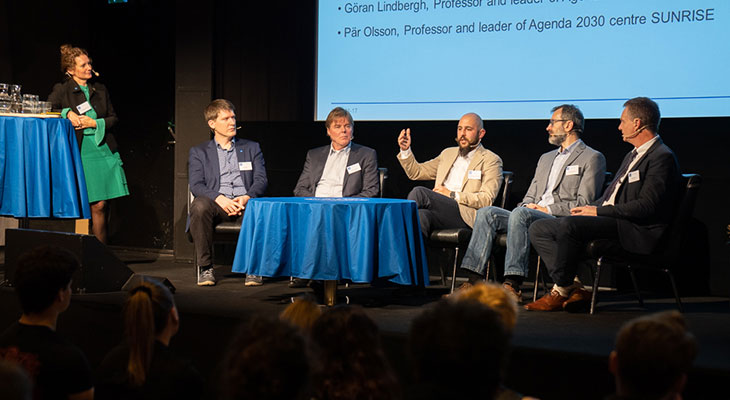
Frassinetti explained how KTH researchers are contributing to the construction of the ITER through the development of materials and the potential of simulating aspects of the plasma reactor operation.
“We’re also involved in research at the Jet fusion reactor in the UK, which last year took the record for maintaining a fusion process to five seconds, which produced ten megawatts of energy. This was an important experiment because it proved previous theoretical predictions,” Frassinetti said.
Pitts added that several Swedish universities and companies are participating in the ITER as well as in other international contexts on the development of fusion technology.
Fernandez then spoke about the development of new generations of solar cells.
“Today’s solar cell market is dominated by silicon, but we’re developing thin film solar cells using perovskite. We’re aiming to develop long-term stable applications. The technology is very promising because it could pave the way to cheaper solutions than those that are currently available and the potential of placing solar cells on more surfaces than just roofs,” he said.
Bertling Tjernberg stressed that KTH conducts advanced research into solar energy and new materials to broaden its use, and by offering a platform for collaboration between different research groups in solar power technology.
Göran Lindbergh then provided an update on advances at the PUSH research centre .
The centre conducts research into cheaper and more efficient hydrogen production, including with the help of new methods and materials.
“We already have very effective methods, for example the development of Hybrit. We now need to train more people to ensure future progress,” Lindbergh said.
Pär Olsson, Director of the SUNRISE research centre that develops technologies for lead-lined SMR reactors.
“Last year, we received a large boost to our funding to develop a research reactor that will be located in Oskarshamn. It will test the technology on a larger scale with the goal of developing sustainable applications in nuclear energy,” he said.
More effective solutions
Following a break with time for networking and mingling, students from SKH returned to perform Belle Nuit from the opera Hoffmann’s Adventure by Jacques Offenbach. Once the applause had died down, the penultimate panel of the day gathered to discuss the theme Energy Efficiency and Transition to Fossil Free Future.
Panellists included Daniel Nordgren, Director Production Planning at Vattenfall, Maria Xylia, Research Fellow Stockholm Environment Institute, Francesco Fuso Nerini, Director of the KTH Climate Action Centre, Viktoria Martin, Professor in Energy Technology KTH, and Christophe Duwig, Professor in Heat Transfer and Reacting Flows KTH.
Nordgren began by stressing that in the short term, it is the development of wind power that is most important for securing the energy supply.
“In the coming 20 years, Sweden’s energy consumption will double. We will address this with a combination of wind and solar energy, while also looking at how we can expand the use of nuclear power. The potential of placing SMR reactors at Ringhals is currently being looked into,” Nordgren said.
He also highlighted how the energy transition creates challenges for the entire energy system and requires small and large adaptations.
“We mustn’t hesitate to think more on a larger scale, including the development of SMRs and large-scale pump solutions to store energy,” he said.
Xylia highlighted the growing trend of new solutions to make energy use more efficient, especially in the EU. However, she stressed that the pace of change must increase dramatically.
Martin highlighted the need for even more solutions to store energy, especially thermal energy, through the development of more compact applications in existing buildings. She gave details about an ongoing project to link different energy sectors to create more flexible and technology-independent storage solutions at the right places in the value chain.
“This is an area in which we face challenges from regulations and in the types of collaboration that currently exist and that need to be improved,” she said.
On this point, Duwig said that today’s energy losses are in many different places and the goal is to access all of them - this is what will make the big difference. He also highlighted the need for new opportunities to extract energy from waste heat even at low temperatures.
“This will require more advanced solutions than those that currently exist and being open to new opportunities to extract more energy from heat produced at, for example, data centres,” Duwig said.
Interest is currently growing in new investments, said Francesco Fuso Nerini, Director of the KTH Climate Action Centre .
“Hopefully, 2022 can be seen as a turning point when interest in investing in renewable energy really took off. In addition, there’s an interest among the public in saving energy, which leads to changes in behaviour that drives climate initiatives,” said Fuso Nerini.
“In academia, we need to identify the knowledge gaps we need to close and create new partnerships that can bring our advances to society,” he added.
Everyone must do their bit in the energy transition, Nordgren said. But suitable formats are required for the creation of new partnerships. Xylia agreed.
“Greater co-ordination is needed, with better opportunities to share knowledge and ideas, especially in those sectors where information is business-critical. We need to consider who can act as neutral actors in this contest,” Xylia said.
New solutions for the high voltage network
The last panel of the day included Magnus Callavik, Global Head of Engineering for HVDC and HVDC Service at Hitachi Energy, Xiongfei Wang, Professor in Power Electronics, Mikael Unge, Adjunct Professor at KTH and NKT High Voltage Cables, Qianwen Xu, Assistant Professor and Head of Intelligent Sustainable Grid Lab KTH, and Lina Bertling Tjernberg, Professor in Power Grid Technology.
The topic for discussion was High Voltage Power Grid Developments and Sustainable Solutions, with Christophe Duwig as moderator.
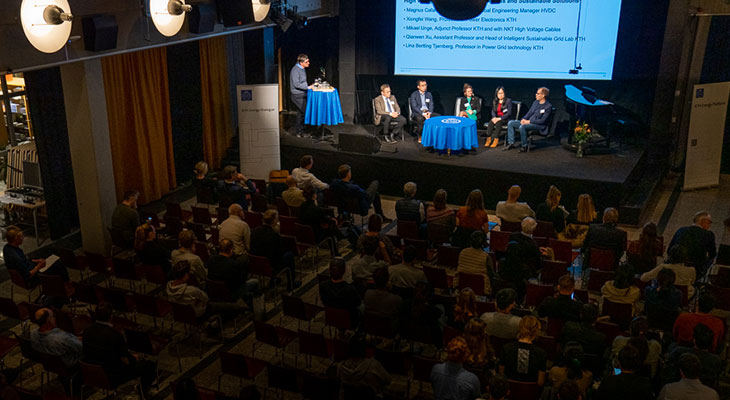
Callavik began with an overview of existing opportunities for transmitting electricity over long distances with the potential of connecting larger installations of wind and solar energy to today’s energy system. He showed several international examples, including an electricity balancing link between Norway’s hydropower and wind and solar energy production in southern Germany.
Wang highlighted some of the difficulties with these new technologies that require a lot of knowledge and analysis. A systematic approach to create systems that are operationally reliable is needed.
“We need greater collaboration between energy producers and electricity grid owners to find new solutions,” Wang said.
Unge saw the need for further research into materials used in cables to better understand the properties of these materials. The goal is to use as little material as possible for more sustainable manufacturing and production. He also talked about the development of new cables for use at sea which, among other things, can withstand forces exerted by waves.
“A lot is being done to manufacture cables with as little environmental impact as possible, including reducing the copper content,” he said.
Xu spoke more about the development of new systems to monitor and operate various energy systems using digital twins and artificial intelligence. This research includes pilot tests of the systems that can be used to control and monitor smaller local self-sufficient energy systems, so-called microgrids.
Bertling Tjernberg mentioned the major shift that has taken place in recent years where large amounts of data can be used to extend the life of technology and create solutions to avoid faults.
“It’s crucial that we think big and go for large-scale solutions, as Magnus Callavik said. We see the development of a growing number of offshore solutions, which are in many ways much more challenging. This is an area where new technologies for monitoring and security are needed.”
Callavik said that the biggest challenge today was not technological; it was financing and obtaining permits.
“Our customers compete to buy all available capacity. The technical solutions already exist today and this makes it possible to connect more renewable energy sources to our energy systems,” Callavik said.
Finally, the prize for best poster was awarded . The award jury was Cissi Askwall, Public & Science, and Francesco Fuso-Nerini from the KTH Climate Action Centre.
Text: Magnus Trogen Pahlén
